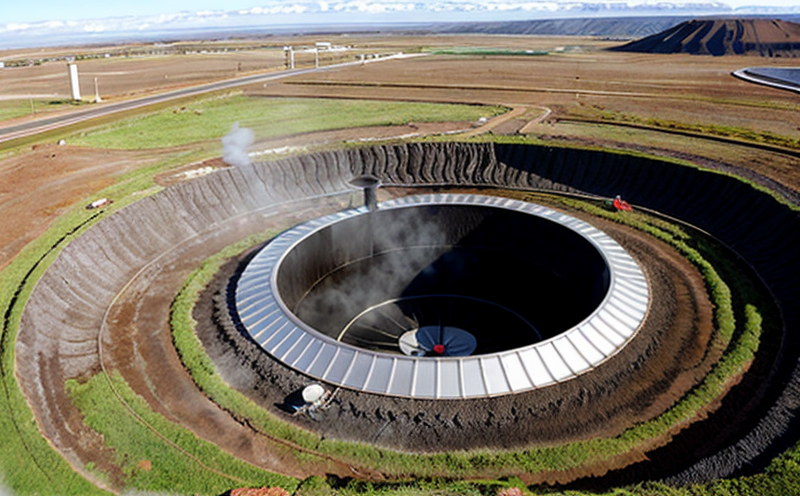ASTM D5334 Thermal Conductivity Testing of Soil for Boreholes
The ASTM D5334 standard method is widely recognized for its role in ensuring accurate and reliable thermal conductivity testing of soil samples, particularly those intended for borehole applications. This service focuses on providing comprehensive testing to support the design, installation, and optimization of geothermal energy systems.
Thermal conductivity plays a crucial role in the efficiency and performance of geothermal heat exchangers within boreholes. Accurate measurement ensures that the system can effectively transfer heat between the ground and the building it serves. This service covers every aspect from specimen preparation to final analysis, ensuring compliance with ASTM D5334.
The ASTM D5334 method involves a transient plane source (TPS) technique, which is used to measure the thermal conductivity of soil samples taken from boreholes. The process starts by carefully selecting and preparing the soil specimens according to standard procedures. Specimen preparation includes ensuring uniformity in size and shape, as well as cleanliness.
The testing apparatus typically consists of a TPS heater, a temperature sensor, and a thermocouple for precise measurement of heat flow through the sample. The method requires careful calibration of the equipment and strict adherence to procedural steps to ensure accurate results. Once the test is conducted, data analysis is performed using software that calculates thermal conductivity based on the heat transfer measurements.
Compliance with ASTM D5334 ensures consistency in testing methods across various regions and industries. This standardization supports quality assurance efforts by providing a common framework for interpreting thermal conductivity values. Compliance also enhances trust between stakeholders, including contractors, engineers, and regulatory bodies.
The service provided includes detailed reports that outline the test procedure, specimen preparation, instrumentation used, and the final results. These reports are crucial for meeting project-specific requirements and ensuring compliance with local building codes and regulations.
Understanding the thermal properties of soil is essential for optimizing geothermal heat exchanger designs. Accurate thermal conductivity values help in predicting system performance under various conditions, which is vital for long-term energy efficiency and cost-effectiveness.
International Acceptance and Recognition
The ASTM D5334 standard has gained widespread international acceptance due to its rigorous methodology and reliability. This method is recognized by numerous countries that have adopted it as a national standard for geothermal energy system testing. Compliance with this standard ensures consistency in test results across different regions, which is essential for global projects.
Many organizations and regulatory bodies around the world use ASTM D5334 to ensure the quality and reliability of thermal conductivity measurements. This includes government agencies responsible for environmental regulation, private sector companies involved in geothermal energy development, and research institutions dedicated to sustainable energy solutions.
The standard's acceptance is particularly significant in regions with diverse geological conditions where accurate soil thermal properties are critical for project success. By adhering to ASTM D5334, stakeholders can ensure that their projects meet international standards, thereby facilitating smoother interactions with global partners and regulatory bodies.
Environmental and Sustainability Contributions
The testing of soil thermal conductivity plays a vital role in enhancing the environmental impact of geothermal energy systems. By accurately determining the thermal properties of soils, this service helps optimize the design and performance of geothermal heat exchangers, leading to more efficient energy extraction.
Optimized designs result in reduced operational costs and lower carbon emissions, contributing significantly to sustainability goals. This service supports the development of renewable energy systems that minimize environmental footprint while maximizing resource utilization.
The accurate measurement of soil thermal conductivity also aids in predicting long-term performance, ensuring that geothermal systems continue to operate efficiently over their lifecycle. This contributes to a more sustainable approach to energy production and consumption, aligning with global efforts towards green energy initiatives.
Use Cases and Application Examples
| Use Case/Application Example | Description |
|---|---|
| Geothermal Energy System Design | Determining the thermal conductivity of soil is essential for designing efficient geothermal heat exchangers. This ensures optimal system performance and minimizes energy consumption. |
| Borehole Installation Optimization | Absolutely crucial in optimizing borehole installation to enhance heat transfer efficiency, thereby improving overall system performance. |
| Renewable Energy Project Compliance | Ensuring compliance with international standards like ASTM D5334 helps in meeting regulatory requirements and gaining stakeholder confidence. |
| Sustainability Initiatives | Supporting sustainability goals by optimizing energy use, thereby reducing environmental impact and promoting greener practices. |
| Research and Development | Aiding in the development of new technologies and materials that improve geothermal system performance. |
| Construction Quality Assurance | Ensuring high-quality construction by verifying that all components meet specified thermal conductivity standards. |
| Energy Efficiency Audits | Promoting energy efficiency through accurate measurement and analysis of soil properties, leading to better-informed decisions. |
The ASTM D5334 standard is indispensable in these applications, providing a robust framework for testing and validating soil thermal conductivity. This ensures that all stakeholders involved in geothermal energy projects have access to reliable data, which is crucial for making informed decisions.





